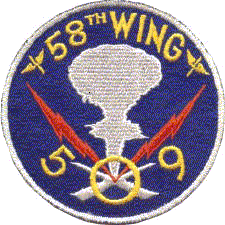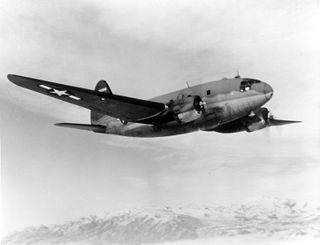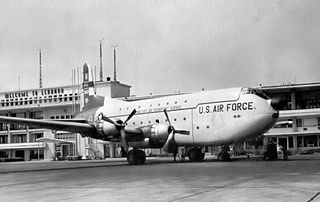
The 509th Composite Group was a unit of the United States Army Air Forces created during World War II and tasked with the operational deployment of nuclear weapons. It conducted the atomic bombings of Hiroshima and Nagasaki, Japan, in August 1945.

The 456th Bombardment Wing is an inactive United States Air Force unit. It was last assigned to the 14th Air Division of Strategic Air Command at Beale Air Force Base, California, where it was inactivated on 30 September 1975. The wing's predecessor was the 456th Bombardment Group, a World War II United States Army Air Forces combat organization that flew from Italy while assigned to Fifteenth Air Force. It earned two Distinguished Unit Citations for valor in combat and participated in the strategic bombing campaign against oil production targets including those near Ploiești, Romania, attacks that resulted in high bomber losses. The group also served as a troop carrier unit in the Air Force Reserve from 1947 to 1949 and as the flying element of the wing from 1952 to 1955.

The 320th Air Expeditionary Wing is a provisional United States Air Force unit assigned to the Air Force District of Washington. It is stationed at Bolling AFB, District of Columbia. The 320 AEW may be activated or inactivated at any time.

The 416th Air Expeditionary Wing (AEW) is a provisional unit assigned to the Air Combat Command of the United States Air Force to activate or inactivate as needed.

The 7th Airlift Squadron is part of the 62d Airlift Wing at McChord Air Force Base, Washington. It operates Boeing C-17 Globemaster III aircraft supporting the United States Air Force global reach mission worldwide.

The 2d Combat Cargo Group is an inactive United States Army Air Forces unit. The unit was organized at Syracuse Army Air Base in New York. It operated during World War II in the Southwest Pacific, transporting passengers and cargo. Its last duty station under this designation was Yokota Air Base, Japan, where it was inactivated on 15 January 1946.

The 302d Air Division is an inactive United States Air Force Division. Its last assignment was with Fourteenth Air Force at Marietta Air Force Base, Georgia, where it was inactivated on 27 June 1949. ' During World War II, as the 302d Transport Wing the unit provided logistical airlift support for United States Strategic Air Forces. It was reactivated as a reserve headquarters in 1946, and was inactivated in 1949 when reserve units converted to the wing base organization and budget restrictions reduced the size of the Air Force.

The 313th Expeditionary Operations Group is a Provisional United States Air Force unit, assigned to United States Air Forces in Europe to activate or inactivate as needed. It was last active at Moron Air Base, Spain, supporting Operations Odyssey Dawn and Unified Protector to enforce a no-fly zone over Libya. It was inactivated on 31 October 2011.

The 47th Airlift Flight is an inactive United States Air Force unit. Its last assignment was with the 375th Airlift Wing at Wright-Patterson Air Force Base, Ohio, where it served as an operational support airlift flight, operating Learjet C-21s from 1997 until 2004.

The 448th Supply Chain Management Group is an inactive United States Air Force unit. Its last assignment was to the 448th Supply Chain Management Wing at Tinker Air Force Base, Texas, where it was inactivated on 30 June 2010.

The 830th Bombardment Squadron is an inactive United States Air Force unit. Its last assignment was with the 509th Bombardment Wing at Pease Air Force Base, New Hampshire. It was active during World War II in the Mediterranean Theater of Operations as a Consolidated B-24 Liberator unit, where it participated in the strategic bombing campaign against Germany. It earned a Distinguished Unit Citation. Following V-E Day, the squadron returned to the United States and began training with the Boeing B-29 Superfortress at Smoky Hill Army Air Field, Kansas. When its parent group was inactivated in 1946, it moved to Roswell Army Air Field, New Mexico, where it joined the United States' first nuclear-capable unit, the 509th Composite Group. The squadron remained part of the 509th until it was inactivated when the wing converted to the Boeing B-52 Stratofortress.

The 781st Bombardment Squadron is an inactive United States Air Force unit. Its last assignment was to the 465th Bombardment Wing, stationed at Robins Air Force Base, Georgia. It was inactivated on 25 July 1968.

The 775th Troop Carrier Squadron is an inactive United States Air Force unit. It was last assigned to the 1st Air Commando Wing at Hurlburt Field, Florida in July 1964.

The 44th Expeditionary Air Refueling Squadron is a provisional United States Air Force unit that was assigned to the 379th Air Expeditionary Wing. It was last known to be stationed at Al-Udeid Air Base, Qatar, where it engaged in air refueling operations in support of United States Air Forces Central.

The 736th Bombardment Squadron is an inactive United States Air Force unit. It was last assigned to the 454th Bombardment Wing at Columbus Air Force Base, Mississippi, where it was inactivated on 2 July 1969 as the United States reduced its inventory of older Boeing B-52 Stratofortresses..

The first predecessor of the squadron was organized in 1940 as the 13th Transport Squadron. During World War II, as the 13th Troop Carrier Squadron, the squadron served in the South West Pacific Theater of World War II, earning two Distinguished Unit Citations, a Navy Unit Commendation and a Philippine Republic Presidential Unit Citation for its wartime actions. Its last assignment was with the 403d Troop Carrier Group at Nichols Field, Luzon, Philippines, where it was inactivated on 15 October 1946.

The 302d Tactical Electronic Warfare Training Squadron was formed in September 1985 by the consolidation of three units which had served in the Army Air Forces or United States Air Force during World War II and the Cold War.

The 320th Troop Carrier Squadron is an inactive United States Air Force unit. It was activated on 17 December 1944, and inactivated on 19 August 1946 at Roswell Army Air Field, New Mexico. The squadron was later consolidated with the 302d Transport Squadron and 302d Tactical Reconnaissance Squadron. The squadron was a support squadron for the 509th Composite Group during World War II. It was formed as the transport unit for the 509th, and due to the highly secret nature of the group, carried all supplies and equipment for Project Silverplate Atomic Bomb activities. It also functioned as a special air transport squadron for high-ranking officers, nuclear scientists and for the group's commander, Lt. Col. Paul Tibbets to meetings concerning Silverplate. The squadron later served as a transport squadron for atomic tests in the Marshall Islands in 1946.

The 516th Aeronautical Systems Group is an inactive group of the United States Air Force (USAF). It was last assigned to the 516th Aeronautical Systems Wing of Air Force Materiel Command at Wright-Patterson Air Force Base, Ohio.

The 3d Troop Carrier Squadron is an inactive United States Air Force unit. It was last assigned to the 63d Troop Carrier Group at Donaldson Air Force Base, South Carolina, where it was inactivated in 1960.

























